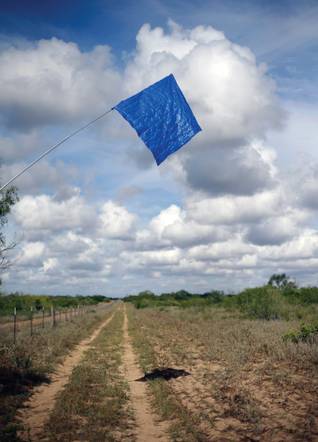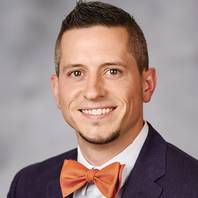
Associated Press file
In this Aug. 23, 2013, photo, a blue flag marks a water station on a ranch near Falfurrias, Texas. Brooks County, home to a Border Patrol checkpoint about an hour north of the border, handled 129 bodies last year of immigrants that died in their attempt to come to the U.S. Brooks County is now trying to improve its services by performing an autopsy on all immigrants and making greater efforts to identify them.
Friday, Feb. 15, 2019 | 2 a.m.
Sometimes they’re buried in unmarked graves. Other times their bodies decompose under the desert’s blaring sun. The mementos carried on their journey—a child’s drawing with a Spanish prayer scribbled on the back, a stuffed animal, a lucha libre mask—are found with them, hinting at who they were before they died.

Dr. Timothy Gocha
Many of these individuals were fleeing violence in Guatemala, Honduras and El Salvador, a region known as Central America’s Northern Triangle, hoping for peace and prosperity only to die in rural American territories before those dreams came to fruition. In these U.S. counties many resources are lacking, so proper investigations and autopsies are left unfinished with only case numbers assigned to an unidentified life in a government database.
Brooks County, Texas, is one such location with 7,235 residents and 630 assumed migrant remains found since 2009, said Urbino Martinez, Brooks County Sheriff. Migrants often venture into these vast desert regions to avoid checkpoints along the border and end up dying from exposure and dehydration.
In the U.S., there’s 4,400 unidentified bodies recovered and logged annually, according to National Missing and Unidentified Persons System. Of those, 1,000 stay nameless after a year and small counties near the border account for a large portion of those.
To help:
Operation Identification is funded through multiple revenue streams, including grants and donations, according to Gocha. To contribute, visit txstate.edu/anthropology/facts/outreach/opid.html
Operation Identification, a project that is part of Texas State University’s Forensic Anthropology Center, works to alleviate the pressure on these areas by giving those human remains their stories back. Founded in 2013 by professor Kate Spradley, the group started as a grassroots effort to identify the growing surge of bodies.
In 2016, it enlisted the help of Dr. Timothy Gocha, now a UNLV adjunct assistant professor ofAnthropology who also works with the Clark County Office of the Coroner/Medical Examiner. At the time, he was a postdoctoral student and managed the day-to-day at Operation Identification (he’s still currently an affiliated faculty volunteer).
• • •
The work with Operation Identification is long and difficult, and it can take years for the organization’s efforts to come to fruition even with a paid staff of two or three and hundreds of students and volunteers.
The team conducts field searches to l0cate bodies in the backyards of ranches, within vast brush in the desert, or even by exhuming unmarked graves. They also partner with the Brooks County Sheriff’s Office, which will notify Operation Identification if a body is found and the group is close by, Martinez said. Bodies are transported to the medical examiner’s office, where they are relinquished to Operation Identification after 30 days if still unclaimed.
Students from Texas State University’s Forensic Anthropology Center then carefully categorize clothes and other items found with the bodies. Bones are cleaned of remaining flesh, dirt or debris before forensic anthropologists measure them, collect their DNA and send it to government databases, hoping for a match with missing person reports from other nations.
“The whole process can be very depressing, but everyone is a person in life, so everyone deserves to be a person in death,” Dr. Gocha said. “They deserve to be more than a case number. They deserve to be more than a John or Jane Doe buried in some rural South Texas cemetery, thousands of miles away from family or friends or anyone who loved or cared about them. We want to be able to return their identity to them and give their family the opportunity to know what happened.”
Trump effect
Brooks County Sheriff Urbino Martinez said the number of migrants crossing the border hasn’t changed since the Trump Administration enacted its immigration policy. The groups crossing are smaller and cross more frequently, however. Instead of a large group of 70 or 80 people, it’s more common to see four groups of 20 people.
Achieving this can take decades or days, depending on the story and clues left behind with the bones.
One Jane Doe had a peculiar spine formation that made identifying her remains easy. Another had an object with a Spanish prayer, signed by its artist, in their possession.
After that, it’s logistics, confirmation of a DNA match and coordinating with the appropriate foreign governments to transport the remains home.
There are cases that weigh on Dr. Gocha’s mind.
The youngest person found by Operation Identification was estimated to be 12 to 14 years old, most likely male, who died in the summer of 2013. He is stillunidentified, Dr. Gocha said.
“It’s heartbreaking. His DNA has been in the system for almost a year now without any identification, which means that his family either doesn’t know or is not place where they can submit DNA.” he said. “There’s so many of them. We don’t know [all] their stories yet.”
Operation Identification collaborates with similar government and nongovernmental organizations on both sides of the border, including the South Texas Human Rights Center, Argentine ForensicAnthropology Team, Colibrí Center for Human Rights and the Forensic Border Coalition to further the investigations of the missing.
The unsolved are uploaded into the National Missing and Unidentified Persons System or Combined DNA Index System with pictures of their belongings.
As of Nov. 1, Operation Identification facilitated the identification of 31 remains out of the 280 unidentified in their care since 2013.
“Even though we haven’t yet been able to identify everyone, we’ve helped dozens of families,” Dr. Gocha said. “Loss is hard for anyone, but when you don’t even know what happened...that is even harder.”
This story originally appeared in the Las Vegas Weekly.
